Audio-gd is a Chinese brand selling homemade devices whose DACs have acquired an excellent reputation. Many of those, the NFB-2, NFB-15, DAC-19 and Master-7 have undergone the assault of our Hi-Res audio files and have all received our Qobuzism award.
On the other hand, we have been a lot less seduced by the SA-31SE headphone amplifier, and in some way, by the object of this new testing ground, the DAC with headphone amplifier and symmetrical preamplifier without feedback NFB-28, a device which provided us with great sound satisfactions, and also with disappointments.
You’ll discover all of that after reading this testing ground dedicated to this Audio-gd NFB-28. The model that we had was equipped with an optional ESS ES9028PRO conversion chip, while the basic version comes with an ES9018 chip.
Presentation
An Audio-gd device commands respect. The NFB-28 DAC with headphone amplifier offers a very functional design, massive and reassuring, with a true power on/off switch. On its right, two headphones locking plugs; the one on top, following the 6.35mm Jack standard, is designed for a standard pair of headphones, and the bottom one is intended to drive a pair of headphones in symmetrical mode.
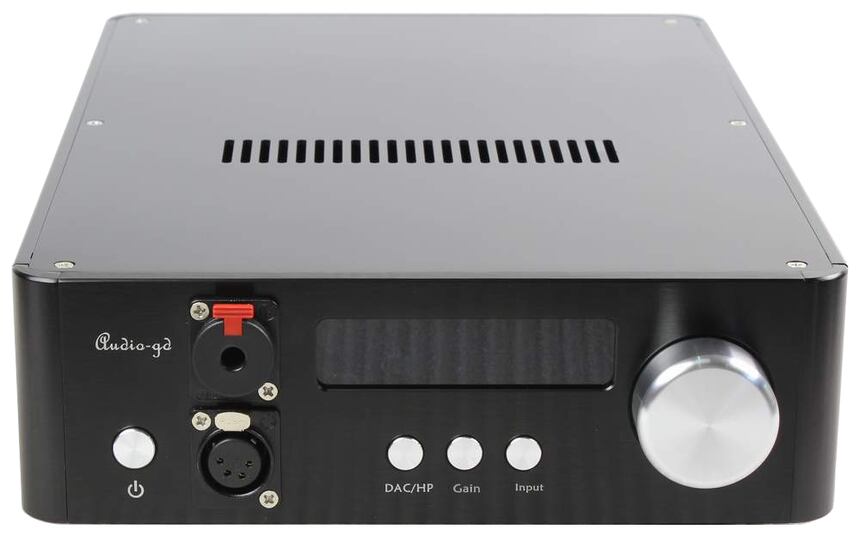
Then comes a large display, very legible and with beautiful blue segments, under which are located three buttons. The first (DAC/HP) allows you to use the NFB-28 DAC with its preamplifier to drive a stereo amplifier, or with its headphone output. The second gives you the choice between four gains and the third selects the source. A small remote comes with the device.
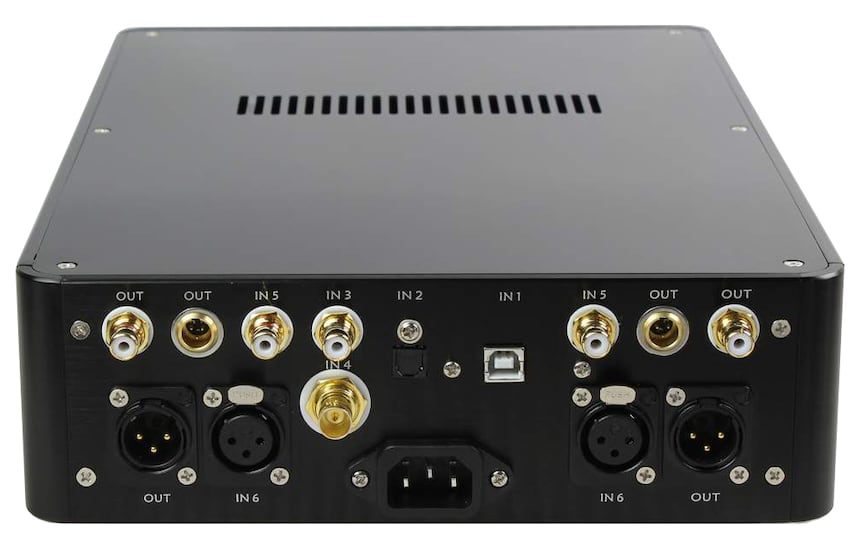
The back is well furnished with its five digital inputs (USB B and three S/PDIFs: one coaxial, one optical and one on BNC), as well as two stereo analog inputs, asymmetrical on RCA, and symmetrical on XLR connectors.
You won’t find any digital output, but there are some stereo analog outputs, asymmetrical on RCA, and symmetrical on XLR connectors and also in Audio-gd Current Signal System format, specific to Audio-gd and requiring a compatible power amplifier from the brand.
Manufacturing
As always with Audio-gd, the focus is on manufacturing. The interior of the solid massive aluminum box is divided into two compartments, one hosting the power supply and the other the digital part as well as the analog, preamplifier and headphone amplifier functions.
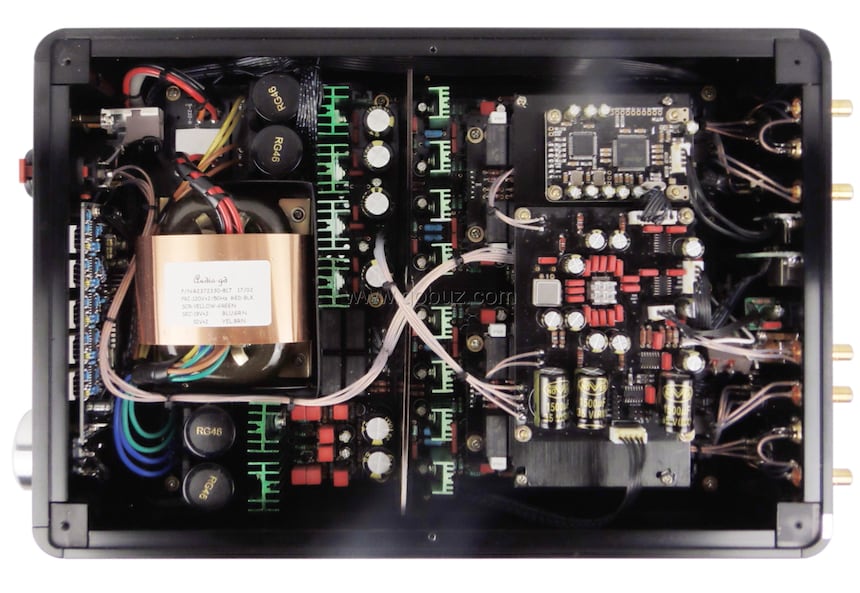
The transformer used by the manufacturer is an R-Core type model with several secondary wirings, among which four deliver a strong current. Each has its own diode bridge accompanied by a Nover LA Audio Grade 3300 μF/50V electrochemical capacitor filtering the rectified current.
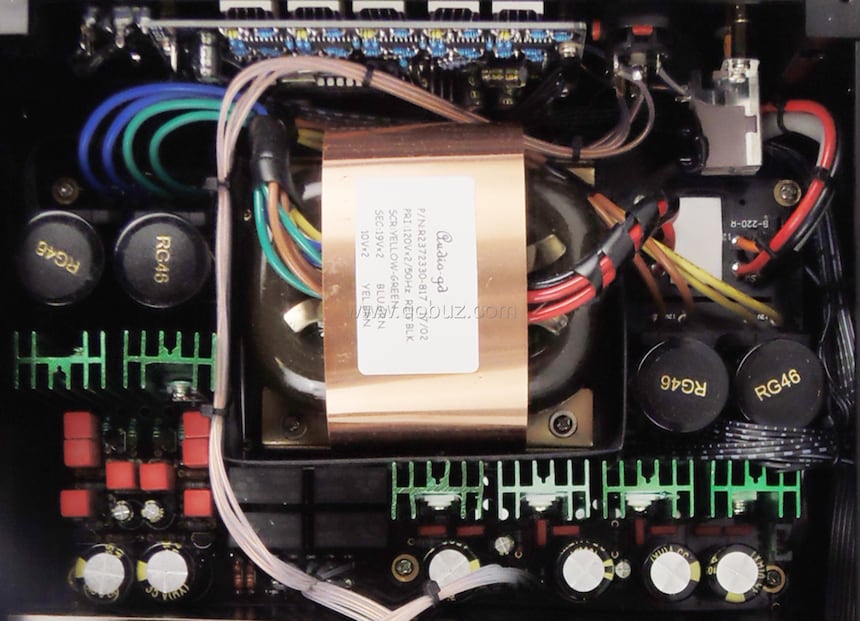
There is also half a dozen regulators mounted on a fan corresponding to as many power supplies filtered by 1500 μF/35V Nover capacitors. The space in the back compartment of the box is divided between the Atmel microcontroller card where is also located the ESS ES9028PRO digital-to-analog converter equipped with a small fan, the Amanero USB interface, the volume control as well as the preamplifier, and the power transistors of the headphone amplifier.
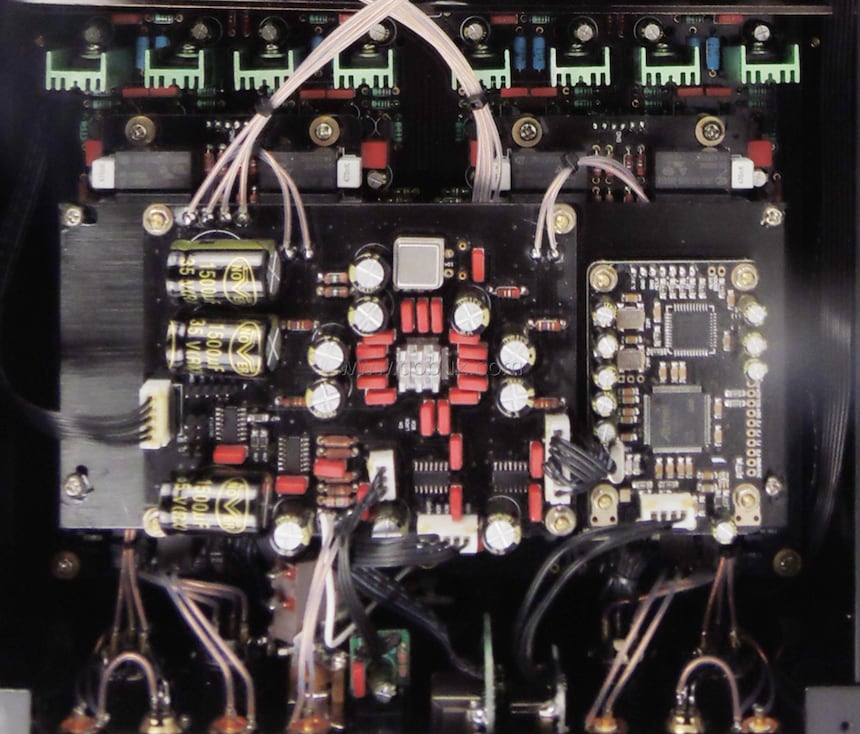
Below is the volume control circuit (for one channel) using a network of resistors commuted by seven relays allowing 128 attenuation levels, rigorously identical on the two branches (of which 80 would be used).
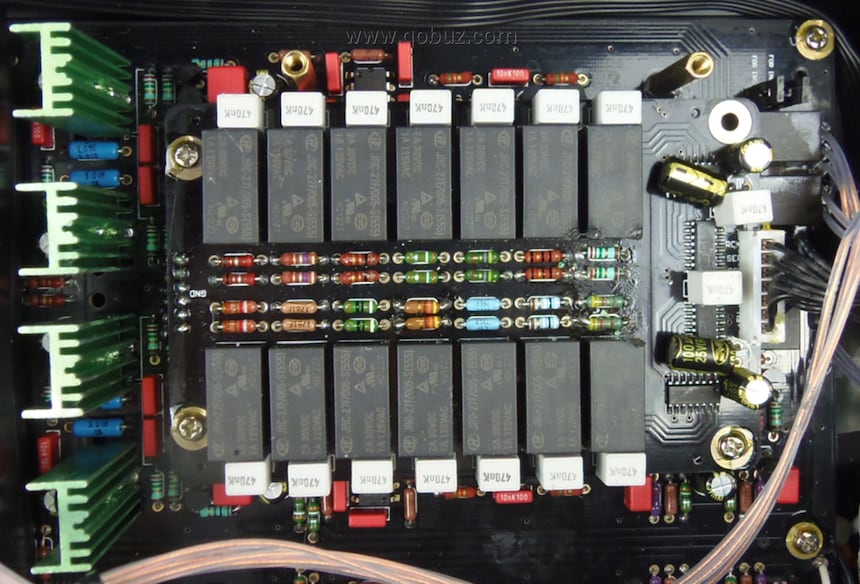
Under this volume card is located the preamplification circuit calling upon the ACSS (Audio-gd Current Signal System) proprietary technology from the manufacturer, using only discreet components, avoiding any feedback to preserve the musicality and transforming into voltage the current signals from the ES9028PRO chip.
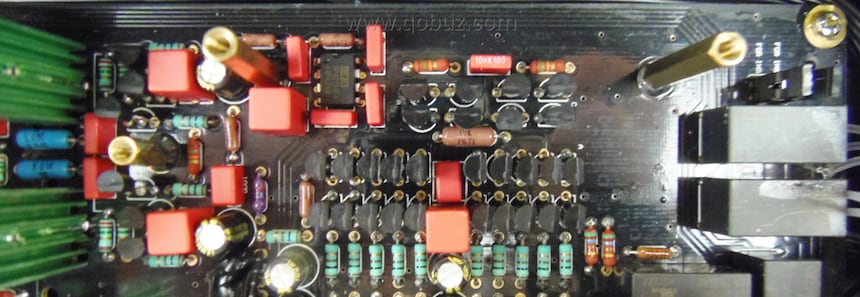
The headphone amplifier adopts a gain stage structure with an OPA2134 operational amplifier, as well as transistors, among which four power models mounted on fan.
Sound
We have chosen for our listening tests Henry Wood’s Fantasia on British Sea Songs , the playback of which was done on PC with Desktop Qobuz with our usual configuration, our (small) Sony UDA-1 amplifier—whose neutrality we like a lot—driving our Triangle Antal Anniversary speakers.
The sound results are high-quality, to say the least, and offer a slight coloration in the top part of the spectrum—this is far from being unpleasant, however—and on the whole all the paintings of this Fantasia on British Sea Songs, whether intimate or full of rhythm, or even glory, are reproduced with a great beauty, where finesse and density enjoy the same favors from the NFB-28. The brass instruments are also striking by their radiance, while the ringing from the triangle rises without effort above the orchestral mass deployed with majesty and the cymbals spring with strength during the final Rule Britannia.
We’ll also note the benefit arising from the absence of feedback from the preamplifier, with notes ending neatly.
The same work, listened from the NFB-28 headphone output on which we plugged our Oppo PM-3, and still with Desktop Qobuz, shows a brilliance a bit clearer than before (this isn’t the same amplification anymore). The brass instruments from the first painting, The Saucy Arethusa, have a field day, while Tom Bowling’s languorous violins are almost reminiscent of Hollywood movies, and the same goes with this very sunny restitution, up to the final Rule Britannia whose brass instruments show a triumphalism that leaves no room for doubt!
But it’s always Desktop Qobuz on our PC that is our source, so the digital-to-analog conversion is handled by the ESS chip, and that allows us to discern only partly the sound print of the headphone amplifier. And thus we will, in order to get to the bottom of things, listen to the same Fantasia on British Sea Songs from one of the analog stereo inputs of the NFB-28.
Our Leaf Audio DAC, equipped with a Burr-Brown PCM5102 chip used without post-filtering—and thus also offering a reproduction without any feedback—, will decode the digital audio flow. And the verdict is immediate: from the first measures of The Saucy Arethusa, we find a sound balance that allows us to appreciate this work in a more native way, let’s say, and the external digital-to-analog conversion by a PCM5102 chip is probably no stranger to this.
This also allows us to note that the headphone amplification offers a nice sound balance, its vivacity and important strength are confirmed, and the over boosted listening with cataclysmic bass of the titles North Star and Silent Space from the album Tale Of Us largely pleads this way.
To conclude, this will not be a surprise because we said so right from the start: this NFB-28 DAC is a device with a thousand sound faces that depend on the signal path and that everyone can appreciate depending on their taste, which can be different from our own. We liked some sound faces, others less so. The debate is open.
NFB-28 on the Audio-gd Website
Playback Capabilities
Audio-gd NFB-28
||About the Audio-gd NFB-28 DAC|| |Type:|Home digital-to-analog converter with symmetrical preamplifier and headphone amplifier| |Function:|Transforms digital audio data into analog signals and amplifies them to drive a pair of headphones or to be connected to a power amplifier| |Digital inputs:|USB B, S/PDIF (1 x coaxial, 1 x optical, 1 x BNC)
AES/EBU on a XLR 3 pins plug| |Analog inputs:|1 x stereo on RCA| |Digital-to-analog converter:|ESS Sabre ES9028PRO (32-Bit/384 kHz,
DSD64 and 128)| |Audio outputs:|6.35 mm headphone Jack, XLR 4 pins in symmetrical mode, preamplifier on RCA and on XLR 3 pins plug in symmetrical mode| |Signal to noise ratio :|> 120 dB| |Frequency response:|20 Hz - 20 kHz| |Max headphone power:|3500 mW / 25 Ω (Jack output)
8000 mW / 40 Ω (symmetrical output)| |Consumption:|25 W| |Dimensions (L x H x P) :|240 x 80 x 360| |Weight:|11.02 lbs (5 kg)| |Design/Manufacturing:|China/China| |R.R.P.:|About 1085 euros| |Contact:|Audiophonics|
